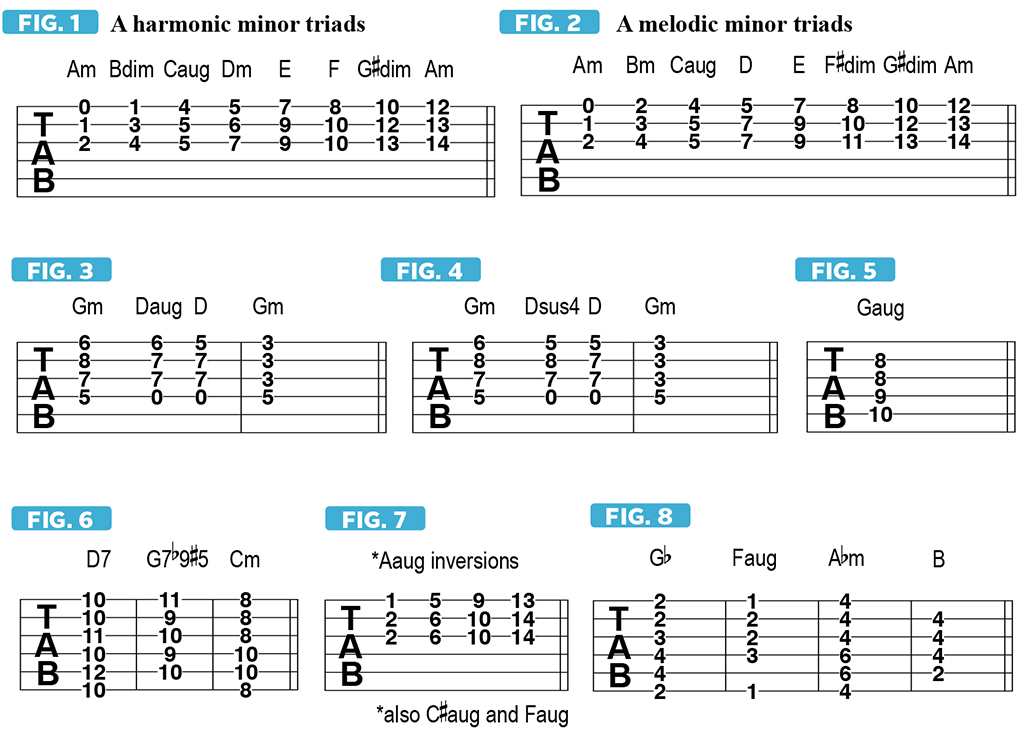Inject some drama into your compositions with the sweetly painful augmented chord
Learn how to use this somewhat painful- yet sweet-sounding chord to dramatic effect
No music theory course would be complete without an examination of the augmented chord, which is a major triad - 1 3 5 - with a raised, or “sharped,” fifth - 1 3 #5 - as signified by the word augmented, which means increased or expanded. In the next few lessons, I’d like to briefly cover the theoretical basis of this occasionally used and somewhat painful- yet sweet-sounding chord and cite a few examples of ways in which musicians have famously employed it for dramatic effect.
The augmented chord is the harmonic minor scale’s third triad - IIIaug, or “III+” (some people use a plus sign to indicate augmented). For example, if you play A harmonic minor (A B C D E F G#) up the neck on three strings, harmonized in thirds and fifths, you get the seven diatonic (scaled-based) triads shown in FIGURE 1, the third of which is C augmented, or Caug (C E G#). This chord also lives within the slightly different A melodic minor scale (A B C D E F# G#), as illustrated in FIGURE 2. Likewise, both E harmonic minor (E F# G A B C D#) and E melodic minor (E F# G A B C# D#) generate Gaug (G B D#).

Classical composers would sometimes use an augmented triad as a variation on the V (five) chord in a minor key, as a way to highlight and intensify a i-V-i (one-five-one) cadence. This was often done in the context of a melodic suspension, which is a “lingering” note that’s held over from a previous chord and “late” to resolve, typically downward, to a new, “correct” chord tone. FIGURE 3 demonstrates this move in the key of G minor, with the note Bb, the minor third of a Gm triad (G Bb D) being held over, or suspended, into the V chord, D (D F# A), resulting in a temporary Daug triad, spelled D F# A# (or Bb), creating a temporary “swelling” effect. Speaking of suspensions, if you were to instead hold the G note into the D chord, before resolving it down to F#, you’d have Dsus4 (D G A), as illustrated in FIGURE 4.
Augmented has a yearning, or longing, quality, as in “I long to be with you,” or “I long for this chord to resolve.” And so, like the dominant 7b9 chord we explored recently, it’s a strong musical spice that should be used tastefully and sparingly.
“Stray Cat Strut” by the Stray Cats (a complete transcription appears in GW July 2019) offers two examples of how to use an augmented chord effectively, in the key of C minor. At 0:05, guitarist Brian Setzer plays a haunting single-note break lick on the middle four strings built around the Gaug chord shape shown in FIGURE 5, which he arpeggiates. And at the end of the song’s second pre-chorus, at 2:45, Setzer strums a voicing of G7b9 that includes the #5, D# (or Eb) on top, which adds that signature augmented bite and additional tension to an already tense-sounding V chord, as in FIGURE 6.
Like the diminished seven chord we explored recently, the augmented triad has a symmetrical intervallic structure, in this case stacked major thirds, and its inversions take the same shape as you play them up and down the neck, four frets apart, as illustrated in FIGURE 7.
So there are really only four unique augmented triads, the other eight being inversions of those four. And, as such, the inversions may be used interchangeably.
A great example of this principle can be found in the inventive bridge section to “Cold as Ice” by Foreigner and the I-VIIaug-ii-IV changes in FIGURE 8, wherein the second chord in the progression, Faug, is used instead of Dbaug, which would be the Vaug chord in the key of Gb. This is interesting because of the use of the first inversion (third in the bass) and the fact that we’re in a major key, which is a topic we’ll explore further next time. In the meantime, you can find a couple of examples of augmented chords put to good musical use in two of this issue’s tab transcriptions: the Red Hot Chili Peppers song “Road Trippin’” and my solo-guitar arrangement of “America, the Beautiful.”
Get The Pick Newsletter
All the latest guitar news, interviews, lessons, reviews, deals and more, direct to your inbox!
Over the past 30 years, Jimmy Brown has built a reputation as one of the world's finest music educators, through his work as a transcriber and Senior Music Editor for Guitar World magazine and Lessons Editor for its sister publication, Guitar Player. In addition to these roles, Jimmy is also a busy working musician, performing regularly in the greater New York City area. Jimmy earned a Bachelor of Music degree in Jazz Studies and Performance and Music Management from William Paterson University in 1989. He is also an experienced private guitar teacher and an accomplished writer.








![Joe Bonamassa [left] wears a deep blue suit and polka-dotted shirt and plays his green refin Strat; the late Irish blues legend Rory Gallagher [right] screams and inflicts some punishment on his heavily worn number one Stratocaster.](https://cdn.mos.cms.futurecdn.net/cw28h7UBcTVfTLs7p7eiLe.jpg)


